5 West, 5 South, 5 East : Niverville to St. Pierre Jolys
Last night we were delighted to discover that GORP bars and goodies are created in an establishment that is located right on the Trans Canada Trail here in Niverville, Manitoba. We're huge fans of GORP bars, which are made in small batches with healthy, clean, nutritious ingredients, so we jumped at the chance to support this local business as we passed through town. It was a pleasure to meet Coleen, the entrepreneur behind GORP, who wanted to create a healthy food to help fuel people's adventures.
After a quick breakfast at Tim Horton's we scuttled across the busy highway to the farm/GORP kitchen, and headed for the winged tractor outside the GORP enterprise. When Coleen learned we were hiking to get people interested in nature and birds she very generously donated a large jar of extremely delicious jellybeans to our order! It turns out she works with Ducks Unlimited, and is a birder as well as an adventure enthusiast. It was great to meet her and be given a special treat to support our trek too!
As we headed along the trail through Hespeler Park it was already hot. We were seriously tempted to join the shrieking and laughing children who were enjoying the splash pad, but we settled for a short break in the shade of a gazebo which hosted Barn Swallows and House Sparrows in adjacent nests, both of which had loudly begging babies.
While here we also found what Sean jokingly referred to as the original Trans Canada Trail Map on the side of the trail. Given that most of our days on the TCT throughout the prairies will average 25-35 km per day but only cross 15 km of landscape the observation seemed fairly apt.
Today our route would take us 5 long concession roads west, then 5 concessions south, and then 5 concessions east to our destination.
While taking a break, we learned that the Park was named after William Hespeler, an entrepreneur, politician, philanthropist, and Honorary Consul of his native Germany. He worked as an immigration agent for the Canadian government, recruiting over 7,000 Mennonites to Manitoba between 1874 and 1880 in one of the first big waves of European migration to the West.
Upon leaving the park we found ourselves surrounded by a sea of lemon yellow canola blossoms in fields extending in all directions. Canola is derived from the rapeseed plant, which belongs in the Brassica family. Brassica plant varieties are some of the oldest plants cultivated by humans, being grown in India around 4,000 years ago. Canola was bred from rapeseed cultivars at the University of Manitoba, and was named for a combination of 'Can' for Canada and 'ola' for oil. Canada is the world's largest producer of canola, which is used for cooking and baking, biodiesel, bio-plastics, pet food, and fertilizer.
As we hiked along, sheltering from the baking sun under our umbrellas, we passed stacks of colourful wooden boxes filled with bees. We could hear their buzzing as we walked alongside the blooming fields, and a few of the industrious bees visited the delicate pink wild roses that improbably bloom at the edges of the gravel roads.
For much of today the trail zigzagged up and down concessions, giving us an idea of the size and shape of the land parcels that settlers farmed along the Red River. These parcels were long and thin, apparently giving each landowner access to water. We'd seen a visual representation of these parcels in the colourful town logo for St. Norbert, and this gave us an opportunity to experience this landscape first hand.
At the junction of the Red and Rat Rivers we came to the Mennonite Memorial Landing Site which we could not photograph or spend time at as another group was relaxing in the glorious shade having a picnic when we arrived and asked us to move on in order to respect social distancing...back into the blazing sun of the concession roads. Sigh.
At this historic spot a wooden archway marks the place where the first group of Mennonite settlers landed in Western Canada on August 1st, 1874. Mennonites originated in Switzerland in the 1500's, and over time moved to the Rhineland, the Netherlands, and then Russia in search of religious freedom. In the 1800's the political climate in Russia became intolerable for them, and at the same time, Canada was searching for experienced farmers to settle the prairies. In return for religious freedom and a reserve of land for their exclusive use, the first 50 Mennonite families arrived from Russia in 1874. A stone cairn now commemorates their arrival at the Mennonite Landing site at the junction of the Red and Rat Rivers.
Although we enjoy learning the history of this region, we can't help noticing that the monuments and cairns tell only half the story - that which belongs to the settlers. As the prairies filled up, the land was cultivated, and the wild bison were made all but extinct, the First Nations people lost their culture and their way of life. They were increasingly pushed into designated reserve areas. Many of the numbered land Treaty agreements included promises of farming equipment to enable the First Nations people to become farmers, something they had no knowledge of or experience doing in the European fashion. Signage is provided along the length of the Trans Canada Trail to inform trail users of the natural and cultural history of the regions they're in, and we think there is a great opportunity here for the trail to collaborate with First Nations groups to help ensure trail users learn a more balanced and complete history.
By early afternoon we had woven our way along the trail to the tiny community of Otterburne. As we approached it, we could see the top of a grain elevator, the steeple of a church, and a modern communications tower stretching towards the sky for several concessions before we reached the town. These symbols seemed to represent the essentials of modern life out here on the prairies.
When we arrived at the edge of town the Crow Wing Trail took us through the Providence University College and Theological Seminary. As we arrived at the edge of the beautiful green campus a driver stopped and asked if we needed directions or anything else, and said he lived on the campus and to drop by if we did. Yet another friendly encounter to brighten our day!
We took a break under the sweet shade of a tree in a tiny park on the edge of Otterburne, and enjoyed some of our delicious GORP treats. After that we crossed a road bridge over the Rat River. Like many of the rivers we've crossed recently, the water levels in this small, meandering, brown river were well below 'normal', leaving several feet of muddy bank exposed.
After this we had several hours of very hot walking down exposed gravel roads. All the drivers who passed us slowed down and pulled way over, almost all of them gave us a friendly wave, and quite a few stopped to chat, which made for an interesting afternoon but rather slow going.
Along the way we also met a cyclist who volunteers on the Post Road Trail near Emerson. He was cycling the Crow Wing Trail to experience what it was like and to see how it connected up with the next trail section, to determine how it could be improved. He shared lots of highly useful information and tips on the upcoming trail sections, as well as kind words of encouragement. In particular, he warned of a difficult section of trail along the Canada-US border that he suggested was very overgrown and riddled with badger holes, and might be better avoided with the carts. Speaking with him made us appreciate our blessings - it might be hot, dry, and dusty right now, but we don't have to slog through sticky prairie mud, and so far the mosquitos haven't been too bad at all.
Another highlight was meeting a resident of St-Pierre-Jolys, just as we entered town. He saw the pilgrim shells on our backpacks and asked if we were doing the Camino. We confirmed that we were walking the Chemin Saint Paul, and that we had completed several of the European Caminos as well. He said he was hoping to be able to walk the Caminho Portuguès this year. He offered us a beer at his place and wished us 'Buen Camino!' before heading off. It was so wonderful to hear those familiar Spanish words of greeting out here on the Canadian Prairies!
On the way in to Saint-Pierre-Jolys we stopped at the Saint-Pierre Jolys Museum. This historic building, which used to be a convent for the Sisters of the Holy Names of Jesus and Mary was closed, but we stopped to explore the treed grounds.
As the name suggests, the town was originally settled along the Crow Wing Trail by francophone people of Métis and Quebecois heritage. The Roman Catholic faith played a significant role in the founding of the town, with many Catholic Fathers, including Jean-Marie Jolys encouraging families from Quebec to relocate to the area.
Today, the town has a population of just over 1,000 residents, and its main industry is dairy farming and livestock. Tourism is also important, and each year the town hosts several festivals including the La Cabane à Sucre (Maple Syrup Festival) in April, Le Festival Chantecler ( a celebration of francophone arts), and the signature Les Folies Grenouilles et Foire Agricoles (St Pierre-Jolys Frog Follies and Ag Fair), which is a village fair featuring the Canadian frog jumping competition. We'd have loved to have been around to watch a real live frog hopping competition!
As we made our way through town, with its unique octagonal library, and its historic church with three large freestanding bells out front, we stopped at a bench in it's well-landscaped and centrally located greenspace with a war memorial. A lady approached and asked what we were doing, and when we explained, she invited us for a drink at the local pub and restaurant. We remained socially distanced at separate tables, and ended up ordering food as well as a cold drink to comply with public health regulations. In the tradition of the very best evenings along the Camino de Santiago, we spent several hours in lively conversation with this very interesting lady and the server.
Our evening reaffirmed our belief that we can learn something from everyone we meet, if we simply remain open to it. The older lady had travelled across Canada by car, and chosen to live her life offline. The younger server couldn't imagine undertaking a journey like ours, or walking so far each day. We pointed out that in an 8 hour shift in the restaurant she likely walked 8 -10 km. In our travels we've discovered that some of the best conversations occur between random people with very different backgrounds and experiences who wouldn't normally interact, but find themselves together and willing to listen. Although we'd had the best intentions of looking up the man we met earlier along the road, afternoon turned to late evening. We were very grateful for this interesting and thought provoking evening along the Chemin Saint Paul.
See you on the trail!
Remember to follow our entire adventure here : www.comewalkwithus.online
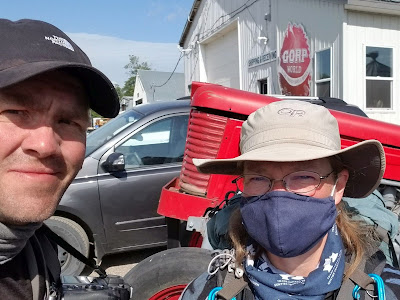


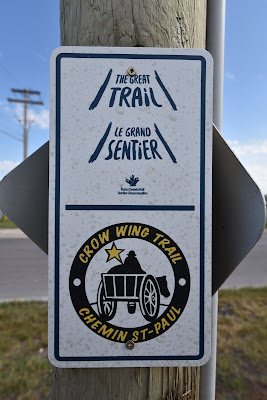





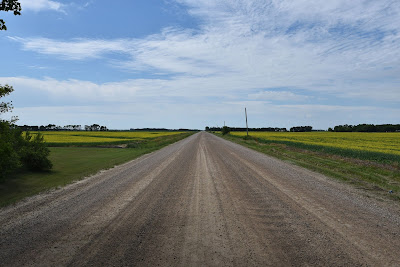
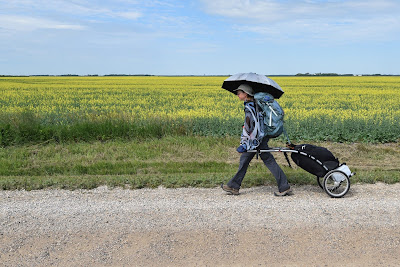





























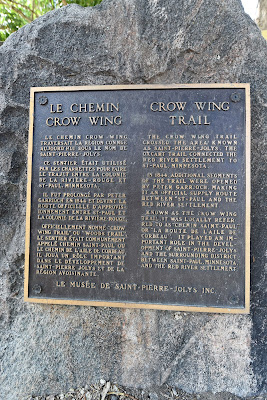




Comments
Post a Comment